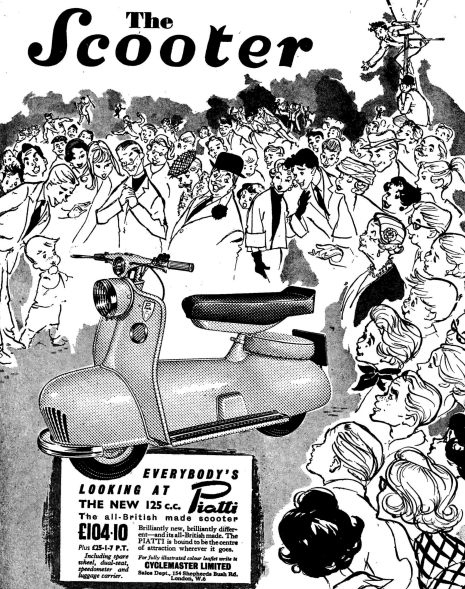 Go
to the Archive index
Go
to the Archive index
"When you are clearing out let mc know how much you want for that." "If you can get it in your car, you can take it now." - So he did!.
"It" was a Piatti scodter, shabby and unused for probably 20 years, in a shed. My brothers told me about it. The 'lucky' gent who had found it was a neighbour of my parents and the Piatti was now in his garage just along the street. The oomments ranging from "amusing" to "hideous" intrigued me, I went over to badger Doug to let me have a look, I was amazed I had never seen anything like it. The body was like a submarine, the nose like a grinning shark and it was tatty, but what a fascinating machine.
Doug is an Ariel man, the shed and garage are crawling with the things, but for him, owning the bits is as far as it seems to go. Bolting them together and making motor cycles out of tham is reserved for "one day". What a busy day that will be. The Piatti would stay in the garage for ever.
I advertised in Motor Cycle Weekly for "any information or spares". Two calls came, one volunteered a workshop manual, the other the owners handbook. A good start, but no one offered spares. I showed Doug the books and he was impressed by my enthusiasm. "We'll come to an arrangement some time." Anyway my brothers kept an eye on it. He at last saw that I was ready and willing to have a go at it and around Easter he let my brother bring it home in the van.
So there it was. What to do? No lights, no saddle cover, no points or carburettor covers, otherwise it was all there. I decided to see if it would start. Big surprise - it wouldn't, no spark. I got new coils, they are the same as one of the Bantams. I bought them from Richard Hackers of Penge, very useful BSA stockists. There was no tap on the tank so I lashed up an old oil bottle and a bit of pipe. It started, about 20 kicks probably, with a bit of rag stuffed in the carb to choke it. The engine started readily after the initial surprise. The best trick was to run it down the hill and bump it, the engine made lots of noise but revved well and pulled strongly. The clutch uss stuck and trying to crash the gear change stalled the motor but it went and that meant it was worth paying proper attention to. The other deciding factor was the tyres. They are of a size 3.50" × 7" that is unique to Piatti and impossible to obtain. The 3 tyres on the scooter were in good condition so it was full steam ahead.
It all came apart quite easily and bits were slipped into labelled envelopes. The bodywork was stripped to bare metal and sprayed up with cellulose of a by now, well known red colour. It is the same colour as used on my James. Three bits needed chroming. The gearchange mechanism had to be fabricated anew and the whole engine checked over. Nothing seemed obviously wrong, so I left well alone. I freed the clutch plate and checked primary chain tension.
The whole thing came back together as easily as it had come apart. It is now more or less completed. I got the engine started and ran it up and down the road. Tho gears ar reluctant to stay engaged at the moment and it needs a bit or wiring up and a new seat cover, but it goes and that makes it fairly special. I still know of only 2 Piatti owners. Someone else must know of them, I'd love to hear from you if you do, I''d love to hear fram you if you don't, but wish you did.
The Piatti scooter was designed by an Italian, Mr Vincent Piatti and put into production in 1956 at the Cyclemaster works at Byfleet in Surrey.
"They faIled to find many customers for this product." So ends the very short Piatti entry in the Erwin Tragatsch Illustrated Encyclopadia of Motorcycles.
The wheelbase was very short and the steering head angle rather steep giving lively steering. The wheels carry 3.50" x 7" tyres on split rims bolted to the hubs in car-like fashion. The integral 123cc engine/gear unit is pivoted on either side of the crankshaft and hangs from from a spring at the rear, attached to the bodywork. The engine moves independently of the body providing the suspension.
The pressed steel body gave complete enclosure. To get at the works the bike could be laid on one side, resting on the edge of one of the footboards and the handlebar end. The footboards run forward to the pressed steel legshields. Above the grille fronted nose is a semi-circular plastic-coated rack for carrying chickens to market. The dual seat was mounted on a post in the fashion of a push-bike and could be adjusted in the same way. On the underside of the seat pan are two hooks, one on the left and one on the right, to hang bags of shopping. The spare tyre is carried at the rear beneath the pillion section of the seat.

Covers in the bodywork reveal the points and chaincase inspection cover on the ofside, and the carb and fuel tap on the nearside. Gearchange is on the left handlebar by way of a twistgrip to the 3-speed box which is at the rear hub. The gearbox design was a weak point and frequently broke.
"...the worst scooter ever perpetrated, and was absolutely lethal." So said Bob Currie in a letter to a friend trying to find out about them. Harsh words perhaps, but probably not far wrong!
This article was first published in the October/November 1984 edition of The Independent, the magazine of the British Two Stroke Club.